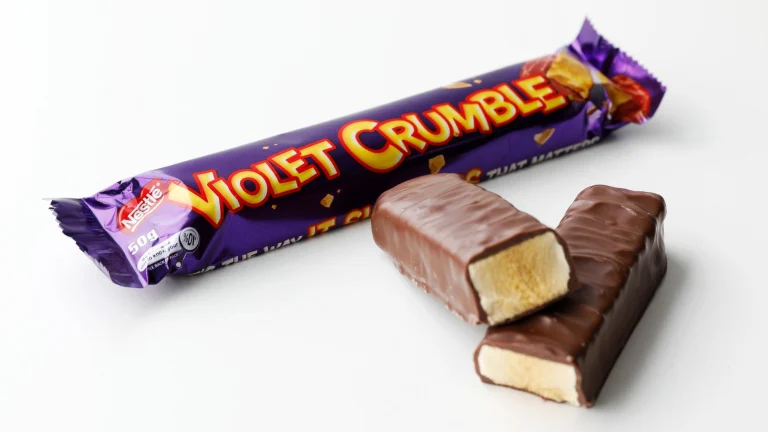The Violet Crumble bar is a crunchy and golden honeycomb covered in dark chocolate.
It was first produced by Hoadley’s Chocolates in South Melbourne around the year 1913; it is currently produced in Adelaide, South Australia by Robern Menz after a period of ownership by Nestlé (see photo below).
Its advertising slogan is: “It’s the way it shatters that matters“, while previously it was “Nothing else matters”.
The bar bears similarities to the Crunchie produced by the British company Cadbury.
For Australians, Violet Crumble bars are similar to Crunchie bars – only better!
Apart from Australia, it is available in Hawaii and a few other places, including Hong Kong, Mollie Stone’s Markets, and Cost Plus World Market in the United States.
Honeycomb toffee, honeycomb candy, sponge toffee, cinder toffee, seafoam, or hokey pokey is a type of candy with brown sugar (and/or corn syrup, molasses, or golden syrup) and baking soda, sometimes with an acid like vinegar.
The baking soda reacts to form carbon dioxide, which is trapped in the highly viscous mixture, and the thermal decomposition of baking soda releases carbon dioxide.
The spongy structure forms while the sugar is liquid, then the candy hardens.
The following is the “home-made” recipe.

- Difficulty: Medium
- Cost: Economical
- Preparation time: 10 Minutes
- Portions: 4 People
- Cooking methods: Stove
- Cuisine: Australian
- Seasonality: All seasons
Ingredients
- 1.5 cups brown sugar
- 0.5 cups honey
- 0.5 cups golden syrup
- 2 teaspoons baking soda
- 13 oz 65% dark chocolate
Steps
Line a large baking tray with parchment paper.
In a pot, combine brown sugar with honey, syrup, and 3 oz of water.
Stir over low heat, then bring to a boil for a few minutes until it reaches 302°F.
Add the baking soda and immediately pour into the tray (see photo).
Cool, break the honeycomb, and cover all sides with melted chocolate.

 This is the reaction upon adding the baking soda.
This is the reaction upon adding the baking soda.
FAQ (Questions and Answers)
What are the other names of Honeycomb toffee?
Cinder toffee in Britain
Fairy food candy or angel food candy in Wisconsin
Hokey pokey in New Zealand
Honeycomb in South Africa, Australia, Britain, Ireland, Philippines, and Ohio
Old fashioned puff in Massachusetts
Puff candy in Scotland
Sponge candy in Milwaukee, Wisconsin, St. Paul, Minnesota, Northwest Pennsylvania, and New York
Sponge toffee (“tire éponge”) in Canada
Turkish honey (“törökméz”) in Hungary
In China, it is called fēngwòtáng (蜂窩糖; “honeycomb candy”) and in Taiwan, it is called
puffed sugar (膨糖, péngtáng or 椪糖, pèngtáng)
It is a traditional sweet in Japan known as karumeyaki ( カルメ焼き), a combination of the Portuguese word caramelo (caramel) and the Japanese word yaki (bake), and can therefore be roughly translated into English as “baked caramel” or “grilled caramel.”
Dalgona (달고나) is a Korean candy made from melted sugar and baking soda.
It was a popular street snack in the 1970s and ’80s and is still consumed as retro food.What is the history of Violet Crumble?
Abel Hoadley opened a jam factory in South Melbourne in 1889, trading as A. Hoadley & Company.
By 1895, the business had expanded rapidly, and Hoadley built a five-story premises, the Rising Sun Preserving Works.
It produced jams, jellies, preserved fruits, candied peels, sauces, and confectionery and employed a workforce of up to 200 people.
By 1901, there were four preserving factories and a large confectionery factory.
Hoadley had acquired the business Dillon, Burrows & Co and extended his products to include vinegar, cocoa, and chocolate.
In 1910, the jam business was sold to the Henry Jones Co-operative, and in 1913 Hoadley’s Chocolates was founded.
That same year, Hoadley produced his first assortment of chocolates, packaged in a purple box decorated with violets, in honor of his wife’s favorite color and flower.
Within the box assortment was a piece of honeycomb that became so popular that Hoadley decided to produce an individual bar.
This proved more complicated than anticipated because, when the honeycomb pieces cooled, they absorbed moisture and stuck together.
This hygroscopic nature of honeycomb led Hoadley to coat his bars in chocolate, to keep the center dry and crunchy, creating the Violet Crumble in 1913.
Hoadley wanted to name his new bar simply Crumble, but as it couldn’t be trademarked, he used his wife’s favorite flower and registered the name Violet Crumble.
It had a purple wrapper with a small floral logo.
It was an immediate success.
Hoadley’s Chocolates was acquired by the English company Rowntree’s in 1970, which produced Violet Crumble in Adelaide until 1985.
Rowntree’s was acquired in 1988 by Nestlé, which moved production to the northern suburb of Campbellfield in Melbourne, until Violet Crumble production was discontinued in 2010.
On January 11, 2018, Robern Menz purchased the Violet Crumble brand and associated intellectual property, plants, and equipment for an undisclosed sum, and production resumed on October 10, 2018.

